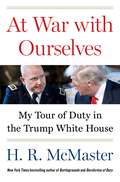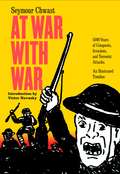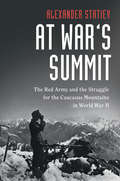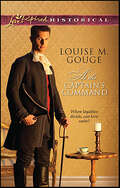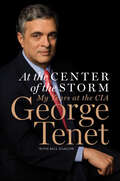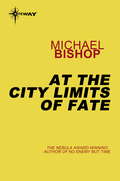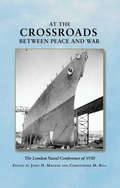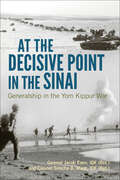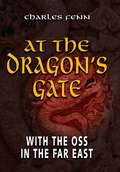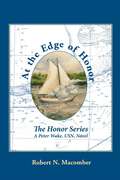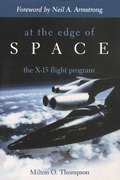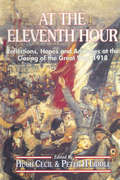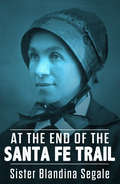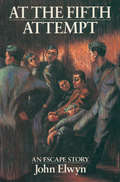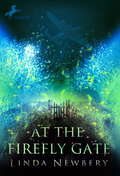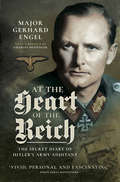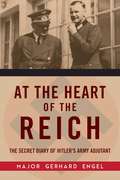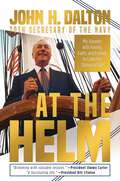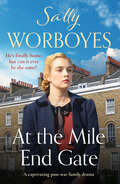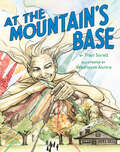- Table View
- List View
At War with Ourselves: My Tour of Duty in the Trump White House
by H. R. McMasterAn Instant New York Times Bestseller!A revealing account of National Security Advisor H.R. McMaster’s turbulent and consequential thirteen months in the Trump White House.At War with Ourselves is the story of helping a disruptive President drive necessary shifts in U.S. foreign policy at a critical moment in history. McMaster entered an administration beset by conflict and the hyper partisanship of American politics. With the candor of a soldier and the perspective of a historian, McMaster rises above the fray to lay bare the good, the bad, and the ugly of Trump’s presidency and give readers insight into what a second Trump term would look like.While all administrations are subject to backstabbing and infighting, some of Trump’s more unscrupulous political advisors were determined to undermine McMaster and others to advance their narrow agendas. McMaster writes candidly about Cabinet officials who, deeply disturbed by Trump’s language and behavior, prioritized controlling the President over collaborating to provide the President with options.McMaster offers a frank and fresh assessment of the achievements and failures of his tenure as National Security Advisor and the challenging task of maintaining one’s bearings and focus on the mission in a hectic and malicious environment.Determined to transcend the war within the administration and focus on national security priorities, McMaster forged coalitions in Washington and internationally to help Trump advance U.S. interests. Trump’s character and personality helped him make tough decisions, but sometimes prevented him from sticking to them. McMaster adroitly assesses the record of Trump’s presidency in comparison to the Obama and Biden administrations.With the 2024 election on the horizon, At War with Ourselves highlights the crucial importance of competence in foreign policy, and makes plain the need for leaders who possess the character and intellect to guide the United States in a tumultuous world.
At War with War: 5000 Years of Conquests, Invasions, and Terrorist Attacks, An IllustratedTimeline
by Seymour Chwast Victor NavaskyAt War with War visualizes humanity's 5,000-year-long state of conflict, chaos, and violence on a continuous timeline. Seventy pages of stark black-and-white pen-and-ink drawings and woodcuts illustrate history's most notorious battles -- from 3300 BCE to the present day. Interspersed are contemplations on war from historic thinkers, including excerpts from "The Art of War" by Sun Tsu, "The Complaint of Peace" by Desiderius Erasmus, and "The State" by Randolph Bourne. Searing and sardonic, balancing anger and despair with wit and humanity, these raw illustrations follow in the tradition of great social satirists such as Honoré Daumier, Frans Masereel, Felix Vallotton, and Otto Dix. Seymour Chwast is a design legend. As co-founder with Milton Glaser of Push Pin Studios, he led a revolution in graphic design in the 1960s and '70s, producing bold, vibrant work that pushed the limits of nearly every visual medium.Now, he turns his pen and sketchpad toward creating a new book on a subject that has been a personal obsession for nearly six decades: the fight against war, humankind's never-ending scourge.
At War with the 16th Irish Division, 1914–1918: The Letters of J H M Staniforth
by Richard GraysonThe letters of John Max Staniforth are among the most perceptive, graphic and evocative personal records of a soldiers life to have come down to us from the Great War. They cover his entire wartime career with the 16th (Irish) Division, from his enlistment in 1914 till the armistice, and they have never been published before. From his first days in the army, Staniforth wrote fluent, descriptive weekly letters to his parents and, in doing so, he created a fascinating record of his experiences and those of the men around him. When the division arrived on the Western Front in 1915, he related his impressions in detail, and went on to give an unflinching account of the drama and the cruelty and the grueling routine of trench warfare. After he was gassed in 1918, he wrote about his feelings and the treatment he received just as thoroughly as he did about every other aspect of the conflict.A striking aspect of the letters is that Staniforth enlisted as a private soldier and went through the training of the ordinary recruit before rising through the ranks. The letters also show how the Irish division was influenced by the turmoil of contemporary politics in Ireland.
At War's Summit: The Red Army and the Struggle for the Caucasus Mountains in World War II (Cambridge Military Histories)
by Alexander StatievThis is the story of the highest battlefield of World War Two, which brings to life the extremes endured during this harsh mountain warfare. When the German war machine began faltering from a shortage of oil after the failed Blitzkrieg against the Soviet Union, the Wehrmacht launched Operation Edelweiss in the summer of 1942, a bold attempt to capture the Soviet oilfields of Grozny and Baku and open the way to securing the vast reserves of Middle Eastern oil. Hitler viewed this campaign as the key to victory in World War Two. Mountain warfare requires unique skills: climbing and survival techniques, unconventional logistical and medical arrangements and knowledge of ballistics at high altitudes. The Main Caucasus Ridge became the battleground that saw the elite German mountain divisions clash with the untrained soldiers of the Red Army, as they fought each other, the weather and the terrain.
At War: The Military and American Culture in the Twentieth Century and Beyond (War Culture)
by Susan L. Carruthers Katherine Ellison Scott Laderman Christine Knauer William Watson John M. Kinder Jennifer Mittelstadt David Kieran Jana K. Lipman Edwin A. Martini Mark R. Wilson Christopher Hamner Sahr Conway-Lanz Stefan Aune Nick Witham Wilbur J. Scott Kara Dixon Vuic Richard P. Tucker Bonnie M. Miller Professor G. Kurt PiehlerThe country’s wars in Iraq and Afghanistan, its interventions around the world, and its global military presence make war, the military, and militarism defining features of contemporary American life. The armed services and the wars they fight shape all aspects of life—from the formation of racial and gendered identities to debates over environmental and immigration policy. Warfare and the military are ubiquitous in popular culture. At War offers short, accessible essays addressing the central issues in the new military history—ranging from diplomacy and the history of imperialism to the environmental issues that war raises and the ways that war shapes and is shaped by discourses of identity, to questions of who serves in the U.S. military and why and how U.S. wars have been represented in the media and in popular culture.
At Your Command
by Julie MillerThe Few. The Proud. The Married.U.S. Marine Zachariah Clark spent his last furlough between the sheets with voluptuous socialite Becky Owens-a steamy week he never wanted to end. So he proposed. They secretly said their "I do's" and Zachariah shipped out on an eighteen-month tour.Stateside again-nursing serious war wounds-Zach begins a tough new mission: getting to know his bride. In the bedroom things are perfect, but outside, Zach has plenty to learn about Becky, a steely divorce attorney who's as fierce a warrior in her own way as he is. The question is: who's giving the orders now?
At Your Pleasure
by Meredith DuranMeredith Duran returns with another witty, humorous and smart romance. Fans of Julia Quinn, Jane Feather and Eloisa James will delight in Meredith's trademark headstrong heroine, cunning hero and tale of deep emotional intensity!By candlelight, she lures him...Glittering court socialites and underworld cutpurses alike know that Adrian Ferrers, Earl of Rivenham, is the most dangerous man in London. Rivenham will let nothing - not the deepening shadow of war, nor the growing darkness within him - interfere with his ambition to restore his family to its former glory. But when tasked by the king to uncover a traitor, he discovers instead a conspiracy - and a woman whose courage awakens terrible temptations. To save her is to risk everything. To love her might cost his life.At swordpoint she defies him...Lady Leonora knows that Rivenham is the devil in beautiful disguise - and that the irresistible tension between them is as unpredictable as the dilemma in which Nora finds herself: held hostage on her own estate by Rivenham and the king's men. But when war breaks out, Nora has no choice but to place her trust in her dearest enemy - and pray that love does not become the weapon that destroys them both...Looking for more Meredith Duran novels? Try Wicked Becomes You or her Rules for the Reckless series.
At the Abyss
by Thomas C. Reed“The Cold War . . . was a fight to the death,” notes Thomas C. Reed, “fought with bayonets, napalm, and high-tech weaponry of every sort—save one. It was not fought with nuclear weapons.” With global powers now engaged in cataclysmic encounters, there is no more important time for this essential, epic account of the past half century, the tense years when the world trembled At the Abyss. Written by an author who rose from military officer to administration insider, this is a vivid, unvarnished view of America’s fight against Communism, from the end of WWII to the closing of the Strategic Air Command, a work as full of human interest as history, rich characters as bloody conflict. Among the unforgettable figures who devised weaponry, dictated policy, or deviously spied and subverted: Whittaker Chambers—the translator whose book, Witness, started the hunt for bigger game: Communists in our government; Lavrenti Beria—the head of the Soviet nuclear weapons program who apparently killed Joseph Stalin; Col. Ed Hall—the leader of America’s advanced missile system, whose own brother was a Soviet spy; Adm. James Stockwell—the prisoner of war and eventual vice presidential candidate who kept his terrible secret from the Vietnamese for eight long years; Nancy Reagan—the “Queen of Hearts,” who was both loving wife and instigator of palace intrigue in her husband’s White House. From Eisenhower’s decision to beat the Russians at their own game, to the “Missile Gap” of the Kennedy Era, to Reagan’s vow to “lean on the Soviets until they go broke”—all the pivotal events of the period are portrayed in new and stunning detail with information only someone on the front lines and in backrooms could know. Yet At the Abyss is more than a riveting and comprehensive recounting. It is a cautionary tale for our time, a revelation of how, “those years . . . came to be known as the Cold War, not World War III.”
At the Captain's Command
by Louise M. GougeDuty and career-Captain Thomas Moberly of His Majesty's Navy prizes them above all. So why is he tempted to relinquish both for Dinah Templeton? Though Dinah seems sweet and charming, the difference in station between an East Florida belle and the son of an earl is too marked to ignore. And all other obstacles pale with the discovery that Dinah's brother James is not what he seems....A war is brewing on the colonies' horizon, and James has chosen his side-in opposition to the country Thomas has sworn to defend. But what of Dinah? Where does her heart truly lie-with her family, or with the man she claims to love?
At the Center of the Storm: My Years at the CIA
by George Tenet Bill Harlow#1 New York Times Bestseller: The former CIA director’s “remarkable” personal account of the mistakes and failures that led to 9/11 and the Iraq War (Bob Woodward, The Washington Post).In this candid memoir, George Tenet recounts his time at the Central Intelligence Agency in the dramatic years between 1997 and 2004. With unparalleled access to the highest echelons of government and raw intelligence from the field, he illuminates the CIA’s painstaking attempts to prepare the country against new and deadly threats, disentangles the interlocking events that led to 9/11, and reveals information on the deliberations and strategies that culminated in the invasion of Iraq.Tenet unfolds momentous events as he experienced them: his declaration of war on al-Qa’ida; the CIA’s covert operations inside Afghanistan; the worldwide operational plan to fight terrorists; his warnings of imminent attacks against American interests to White House officials in the summer of 2001; and the plan for a coordinated and devastating counterattack against al-Qa’ida laid down just six days after the attacks.Tenet’s compelling narrative then turns to the run-up to the Iraq War, including a firsthand account of the fallout from the inclusion of “sixteen words” in the president’s 2003 State of the Union address; the true context of Tenet’s own famous “slam dunk” comment regarding Saddam’s WMD program; and the CIA’s critical role in an administration predisposed to take the country to war. In doing so, he sets the record straight about CIA operations and shows that the truth is more complex than many believe.Throughout, Tenet paints an unflinching self-portrait of a man caught between the warring forces of the administration’s decision-making process, the reams of frightening intelligence pouring in from around the world, and his own conscience—in a moving, revelatory profile of both an individual and a nation in crisis, and a revealing look at the inner workings of the world’s most important intelligence organization at an extraordinarily challenging time.“Tenet does not shy away from acknowledging his own responsibility in controversies involving terrorism and the Iraq War, but he also takes several key political leaders to task for scapegoating the intelligence community in the wake of unpopular policy.” —Publishers Weekly
At the City Limits of Fate
by Michael BishopThese 15 works from the Nebula Award winner and Hugo and World Fantasy Awards nominee, Michael Bishop, previously appeared in Omni, Asimov's The Magazine of Fantasy and Science Fiction and other magazines and anthologies between 1981 and 1996.
At the Crossroads Between Peace and War
by Christopher Bell John H. MaurerA great power arms race in naval weaponry and platforms, rising challengers seeking to overturn the existing international order in Asia, an economic slump that put immense pressure on politicians in democracies to trim defense budgets, and diplomatic efforts by statesmen to find ways to promote mutual security and avoid rivalries that could lead to war-all these features mark the current-day strategic environment. These features also marked in the era between the two world wars. To prevent the naval rivalries that augured international conflict, statesmen and naval leaders sought to negotiate arms control agreement. Their efforts to avert a great power naval arms race were crowned with achievement at the London Conference of 1930.What was accomplished at London, of course, did not prove lasting; nor did it lead to additional meaningful arms control and prevent future wars. Instead, London proved a dead end in the evolution of interwar international relations. The London Treaty marked the high point of interwar arms control. When measured against the magnitude of the international catastrophe that would unfold over the next decade, this achievement in arms control now appears practically meaningless at best and dangerous at worst. Critics of interwar arms control argue that, by weakening of American and British naval power, as well as stirring up extremist nationalism in Japanese internal politics, the London agreement represents a case study in political folly that contributed to the awful events leading to the war. The London Conference of 1930 thus represents a watershed, a turning point in the history of the interwar period.In this volume, leading naval historians tackle the question of how to assess the role played by naval arms control in the history of the interwar period. In addressing this important question, the authors uncover new evidence about the role of intelligence and behind-the-scenes political deal making that adds much to our knowledge of the international and naval history of this important era. This volume's authors provide the first complete account of the strategic calculations and negotiations that shaped the outcome at the London Conference. No one interested in twentieth-century naval history, international relations and the rivalries of rising and declining great powers, and the origins of the Second World War can afford to miss this important new history.
At the Decisive Point in the Sinai: Generalship in the Yom Kippur War (Foreign Military Studies)
by General Jacob Even Colonel Simcha B. MaozA commander and an officer with the IDF recount their experiences in the Yom Kippur War, offering insight into Israel&’s military leadership.At the Decisive Point in the Sinai is a firsthand account of Operation Stouthearted Men—arguably the 1973 Yom Kippur War&’s most intense engagement. General Jacob Even and Colonel Simcha B. Maoz were key leaders in Major General Ariel Sharon&’s division. Together, Even and Maoz recount the initial stages of the Suez crossing, examine the Israel Defense Forces&’ (IDF) response to Egypt&’s surprise attack, and explain Sharon&’s role in the transition from defense to offense. They detail Sharon&’s struggle to convince his superiors of his plan and argue that an effective division commander is not only revealed by his leadership of subordinates but also by his ability to influence his senior officers. Even and Maoz challenge students of military leadership by offering a case study on effective leadership. &“At the Decisive Point is the single best volume I have ever read on the Yom Kippur War. It bridges the gap between the two standard forms of writing on the 1973 conflict?the memoir and the historical monograph?and does so in a very effective manner.&” —Robert M. Citino, author of The Wehrmacht Retreats: Fighting a Lost War, 1943 &“The authors&’ work, in sum, presents an interesting and informative account of the Yom Kippur War on the Sinai front.&” —Israel Affairs
At the Dragon's Gate
by Charles FennIn the early days of World War II, a young Marine named Charles Fenn was recruited by the Office of Strategic Services (OSS) for undercover operations in the China-Burma-India theatre. Fenn knew exactly what it took to get the job done. His wartime exploits are the stuff of legend, but not even his OSS compatriots knew the full extent of his espionage activities. Fenn's skill as a spy is matched by his talent as a storyteller, and this witty, elegantly written account of his OSS days not only adds to the historical record, it makes for a compelling read.
At the Edge of Honor (Honor Series)
by Robert N. MacomberRobert Macomber's Honor series of naval fiction follows the life and career of Peter Wake in the U.S. Navy during the tumultuous years from 1863 to 1901. At the Edge of Honor is the first in the series and winner of the Patrick D. Smith Literary Award for Best Historical Novel of Florida.The year is 1863. The Civil War is leaving its bloody trail across the nation as Peter Wake, born and bred in the snowy North, joins the U.S. Navy as a volunteer officer and arrives in steamy Florida for duty with the East Gulf Blockading Squadron. The idealistic Peter Wake has handled boats before, but he's new to the politics and illicit liaisons that war creates among men. Assigned to the Rosalie, a tiny, armed sloop, Captain Wake commands a group of seasoned seamen on a series of voyages to seek and arrest Confederate blockade-runners and sympathizers, from Florida's coastal waters through to near the remote out-islands of the Bahamas.Wake risks his reputation when he falls in love with Linda Donahue, whose father is a Confederate zealot, and steals away to spend precious hours with her at her Key West home. Their love is tested as Wake learns he must make the ugly decisions of war even in a beautiful, tropical paradise—decisions that take him up to the edge of honor.
At the Edge of Space: The X-15 Flight Program
by Milton O. ThompsonIn At the Edge of Space, Milton O. Thompson tells the dramatic story of one of the most successful research aircraft ever flown. The first full-length account of the X-15 program, the book profiles the twelve test pilots (Neil Armstrong, Joe Engle, Scott Crossfield, and the author among them) chosen for the program. Thompson has translated a highly technical subject into readable accounts of each pilot's participation, including many heroic and humorous anecdotes and highlighting the pilots' careers after the program ended in 1968.
At the Eleventh Hour: Reflections, Hopes and Anxieties at the Closing of the Great War, 1918
by Hugh Cecil Peter H. LiddleFollowing on from the highly acclaimed Facing Armageddon and Passchendaele in Perspective, At the Eleventh Hour recognises that a world was ending in November 1918, and by international collaboration on the 80th Anniversary we learn through this book, what it was like to experience the transition from war to peace. Distinguished historians brilliantly convey a sense of immediacy as the Armistice is recreated and analysed.The reader will not just acquire new areas of information, he will have some of the existing knowledge which he thought was soundly held, strikingly challenged in the pages of this superbly illustrated book.
At the End of the Santa Fe Trail
by Sister Blandina SegaleAt the End of the Santa Fe Trail, first published in 1932 (and reprinted in 1948), is Sister Blandina Segale's account of her life in the southwestern U.S. from 1872 to 1892. Sister Blandina (1850-1941), born in Italy and emigrating with her family to Cincinnati when she was a child, worked with the poor, the sick, immigrants, prisoners, and Native Americans while in Trinidad, Colorado, and in Santa Fe and Albuquerque, New Mexico (and later in Ohio). The book is based in large part on her journal and on the letters she exchanged with her sister Justina, who was also a religious sister in Ohio. At a time when lawlessness and brutality were the norm, Sister Blandina displayed courage, tough-mindedness, and a deep religious faith in service to the less-fortunate. Recent efforts have been made by the Archdiocese of Santa Fe to have Sister Blandina made a saint.
At the Fifth Attempt: An Escape Story
by John ElwynThis tells the story of a soldier caught before the evacuation at Dunkirk, and his daring escape and life along the way.
At the Firefly Gate
by Linda NewberyHenry has always felt like an outsider and things are about to get worse when his family moves to the countryside and the prospect of a new school looms. He retreats more and more into his shell, until he meets Dottie, a frail old lady, who has tremendous spirit. He feels as though he knows her, as though they have been friends for many years. And as she tells him about her wartime romance with a Royal Air Force navigator also named Henry, our Henry is drawn into that world. In a series of mysterious, sometimes frightening events he re-enacts Henry's life . . . and learns that despite being dreadfully afraid, Henry acted heroically at the cost of his own life. Only our Henry knows the true story and it shows him a way through his own self-doubts and misgivings. From the Hardcover edition.
At the Heart of the Reich: The Secret Diary of Hitler's Army Adjutant
by Major Gerhard EngelVivid, personal and fascinating. Simon Sebag MontefioreGerhard Engel was Hitlers Army Adjutant from March 1938 to March 1943. During this time he kept a diary, and after the war he added material to shed further light on key events and decisions.He discloses the decision-making process behind many of the key operations and addresses the intrigues within Hitlers inner circle, recounting the Fhrers conversations with Halder, Guderian and Brauchitsch. Engel also details Hitlers views on German Jews, and in the final part of the diary he covers the war against Russia. Increasingly, towards the end, he depicts Hitler as a vacillating and contrary man.At the Heart of the Reich offers a unique and intimate view of Hitler and his closest aides. It reveals the mechanisms and personalities of the centre of the Third Reich, and provides a fresh perspective of the Nazi leadership.
At the Heart of the Reich: The Secret Diary of Hitler’s Army Adjutant
by Gerhard EngelA revealing account of Hitler's thoughts and actions throughout World War II from one of his closest aides.Major Gerhard Engel was Hitler's army adjutant from 1938 to 1943. During his years with Hitler, Engel kept a diary. After the war, he added material to shed further light on certain events, military and political decisions, and Hitler's attitude to particular problems. His diary covers the decision-making process behind crucial military actions, including the annexation of Austria, the invasion of Czechoslovakia, and the war against Russia. He also addresses intrigue within Hitler's inner circle and his casual conversations with other key Nazi figures.At the Heart of the Reich sheds important light on the Fuhrer's core beliefs. It includes the statement made by Hitler in 1941, "I am now as before a Catholic." It also details his views on German Jews and dwells on the extent to which they served in the Wehrmacht. Engel also addresses the deportation of Jews from Salonika and Hitler's order to Himmler to select a destination, the details of which Hitler was apparently unconcerned with. The final part of the diary is mostly devoted to the war against Russia. Engel's reports confirm that the master plan was to take Leningrad and Rostov, then close pincers behind Moscow. The plan was frustrated by senior army commanders'' lack of enthusiasm and Hitler's failure to exert firm leadership. Engel depicts Hitler as a vacillating, contrary man. It is not unlikely that this encouraged his generals to impose themselves and argue their plan to rush Moscow, which ultimately contributed to the defeat of the Third Reich.Skyhorse Publishing, along with our Arcade, Good Books, Sports Publishing, and Yucca imprints, is proud to publish a broad range of biographies, autobiographies, and memoirs. Our list includes biographies on well-known historical figures like Benjamin Franklin, Nelson Mandela, and Alexander Graham Bell, as well as villains from history, such as Heinrich Himmler, John Wayne Gacy, and O. J. Simpson. We have also published survivor stories of World War II, memoirs about overcoming adversity, first-hand tales of adventure, and much more. While not every title we publish becomes a New York Times bestseller or a national bestseller, we are committed to books on subjects that are sometimes overlooked and to authors whose work might not otherwise find a home.
At the Helm: My Journey with Family, Faith, and Friends to Calm the Storms of Life
by John H. DaltonFrom modest beginnings to Secretary of the Navy, John Dalton&’s life is an inspirational story filled with successes and failures in both the public and private sectors and how he navigated through them. INSIDE LOOK FROM SOMEONE WHO WAS THERE: Secretary of Navy during major crises including Tailhook, the Naval Academy cheating scandal, &“Don&’t Ask, Don&’t Tell,&” and women serving in the military. WELL-CONNECTED AND RESPECTED PUBLIC SERVANT: Author recounts interactions with such public figures as President Carter, President Clinton, Billy Graham, Roger Staubach, Bill Proxmire, Rahm Emanuel, George Steinbrenner, Lloyd Bentsen, Dianne Feinstein, and Hillary Clinton. Blurbs from some of these notable names included in marketing materials and the interior of the book. PLANNED SPEAKING ENGAGEMENTS: Author to speak at the Sonoma Valley Authors Festival, Army and Navy Club, Metropolitan Club, and Cosmos Club (all in Washington, DC) and at book parties around the country.
At the Mile End Gate (The East End Sagas)
by Sally WorboyesIs their love strong enough to weather the storm?It’s 1945, the war is over and the soldiers are coming back to the bomb-ravaged East End. Tom Smith is one of the thousands who are returning home. He can’t wait to see his wife, Jessie, their son, Billy, and the new baby daughter he hasn’t even laid eyes on.But life back home wasn’t easy, especially once Jessie’s army pension was stopped after Tom deserted. So when she was told to put her infant daughter Emma-Rose into a home for her own good, she thought it was for the best. But how will Tom take the news? And how will he react when he learns that Jessie’s old boyfriend has been helping her during the war?A compelling family drama set in London, perfect for fans of Katie Flynn and Mary Collins.
At the Mountain's Base
by Traci SorellA family, separated by duty and distance, waits for a loved one to return home in this lyrical picture book celebrating the bonds of a Cherokee family and the bravery of history-making women pilots.At the mountain's base sits a cabin under an old hickory tree. And in that cabin lives a family -- loving, weaving, cooking, and singing. The strength in their song sustains them through trials on the ground and in the sky, as they wait for their loved one, a pilot, to return from war. With an author's note that pays homage to the true history of Native American U.S. service members like WWII pilot Ola Mildred "Millie" Rexroat, this is a story that reveals the roots that ground us, the dreams that help us soar, and the people and traditions that hold us up.
